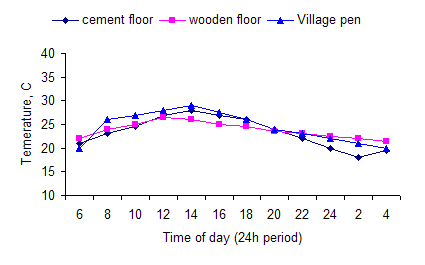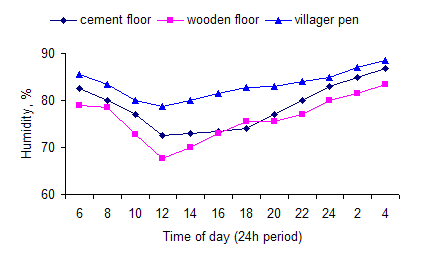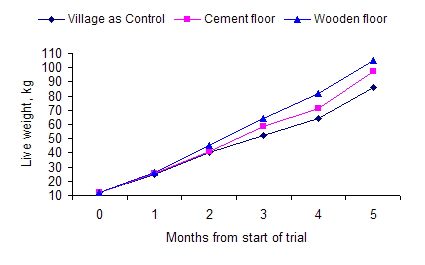Effect floor types on performance and health of F1 (Yorkshire x Mong cai)
fattening pigs and of Mong cai gilts raised by smallholders
Pham Khanh Tu, Hoang Nghia Duyet, Nguyen Thi Vinh,
Brian Ogle* and Antol Beynen**
Hue University
of Agriculture and Forestry
* Department of Animal Nutrition and Management, Swedish University of Agricultural Sciences,
Uppsala, Sweden
** Utrecht University, Netherlands
Abstract
Three type of floor housing were constructed using locally available materials with the aim of studying perceived welfare effects on performance of crossbred (Yorkshire x Mong Cai) fattening pigs and Mong Cai gilts.
The raised wooden floor provided better welfare conditions, and supported higher growth rates, than the cement floor and the traditional village floors. Gilts kept on raised wooden floor had fewer leg problems and a decreased veterinary cost. There was no interaction between breed and floor type for the traits studied in this experiment.
It is concluded that the raised wooden floor type is appropriate for small-scale pig production systems in Central Vietnam, especially in areas where flooding often occurs.
Key Words : Floor type , Mong Cai , F1(Yorkshire x Mong cai), productive traits
Introduction
Many factors influence growth and other performance traits of pigs. Breed, sex and nutrition influence the growth rate and carcass quality (Christian 1980; Langlois and Minviell 1989). Climatic variations and season have been shown to have effects on productivity of sows and growth of piglets (Truong Huu Dung et al 2000). According to the report of Le Thanh Hai and Che Quang Tuyen (19--) the type of housing can affect the litter size and weaning weight of piglets.
Thuy Luong village is located in a lowland area where flood often occurs in the rainy season, causing difficulties for farmers in raising their animals, especially the pigs. This village is one of the poorest in Thua Thien Hue Province. Pigs are very important to the villagers as the principal source of income, for raising funds for particular purposes, and as source of protein for the family. The pig housing system used by the farmers has many deficiencies, including lack of light and ventilation and wet and humid environment. The pigs often have problems of welfare and health.
On the basis of these observations it was decided to study the influence of the type of floor on the performance and health of F1 (Yorkshire x Mong Cai) fattening pigs and Mong Cai gilts raised in farm households in Thuy Luong village.
Materials and methods
Twelve F1 crossbred pigs with initial body weight of 12 kg and 12 Mong Cai purebreed gilts were allocated to three treatments (types of floor), taking account of body weight. The floor types were:
- Raised wooden floor
- Cement floor
- Traditional floor used by farmers (ground level on bare soil)
The sheds were made from locally available materials, including bamboo poles and branches from Eucalyptus trees for the walls and "Imperata" grass for the thatch roof. The raised wooden floor (WF) and the cement floor (CF) were 50 cm above ground level, compared with the village traditional floor at ground level. The size of the pens was 2.5x1.5m for 2 fattening pigs or for 1 gilt.
The same diet with 14% crude protein in DM (Tables 1 and 2) was fed to the fattening pigs and the gilts. The daily amounts that were fed were 1.5 increasing to 2.0 kg DM/pig /day for the first three months of age then increasing to 2.5 and to 3.5 kg DM/pig/day from four to six months of age.
|
Table 1. Chemical composition of the ingredients in the experimental diets |
|||
|
|
DM % |
CP |
MJ/ kg |
|
Rice bran |
90 |
10.3 |
11.0 |
|
Cassava root meal |
87 |
4.9 |
17.4 |
|
Maize meal |
94 |
8.7 |
12.7 |
|
Groundnut cake |
90 |
45.5 |
14.1 |
|
Water spinach ( Ipomea aquatica) |
8 |
18.9 |
0.9 |
|
Fish meal |
88 |
43.9 |
12.1 |
|
Sweet potato |
14. |
2.4 |
1.2 |
|
|
|
|
|
% DM basis |
|
Groundnut cake |
11 |
|
Rice bran |
70 |
|
Cassava meal |
10 |
|
Fish meal |
10 |
Procedure
The pigs were purchased from the local State breeding farm, after weaning (10 to 12 kg live weight). After 1 week for adaptation and vaccination, they were allocated to two groups of farmers (12 farmers per group), one having raised wooden floors in the pig pen, and the other having a raised cement floor. Twelve F1 and six Mong Cai piglets raised in the traditional housing of the villagers served as control animals.
Each month, the temperature and humidity in the pens were recorded every two hours over a 24h period. The pigs were weighed every month and the back fat thickness measured by ultrasonic machine. Feed intake was recorded daily to calculate feed conversion. Observations were made on the gilts in relation to incidence of leg problems and mastitis.
Statistical analysis
Performance traits and health observations were subjected to analysis of variance using the GLM option of the SPSS software (version 10.0). The floor system and breed were used as independent variables. The statistical analysis assumed the following model:
Yijk =
μ
+ Gi + Hj + Gi*Hj + Eijk
Where Yijk = the Kth observation in the ith
breed and jth floor type,
μ
= overall mean, Gi random
Results and Discussion
The relative humidity (Figure 1) and the ambient temperature (Figure 2) were
lowest in the pens with raised wooden floors. Highest values were in the
traditional village pen.
The pen with the wooden floor provided better ventilation that caused
the pen
to be cooler at

Figure
1: Effect
of floor type on the change of temperature during 24 period

Figure 2: Variation in relative humidity during a 24h period of measurement
Changes in live weight of the F1 crossbred pigs during the trial showed obvious benefits for the pens with raised wooden floors, followed by those with the raised cement floor with the traditional village pen giving the poorest results (Figure 3). As expected the crossbred pigs grew faster, were leaner and had better feed conversion than the purebred Mong Cai (Table 3).

Figure 3: The effect of
floor type on the live weights of the F1 fattening pigs
|
Table 3: Mean values for effects of floor type and breed on performance traits of pigs |
|||||||||
|
Floor type |
Wooden floor |
Cement floor |
Village pen |
SEM |
Prob. |
||||
|
LW gain, g/d |
431 |
408 |
383 |
6.02 |
0.001 |
||||
|
Back fat, mm |
28.1 |
28.2 |
28.1 |
0.050 |
0.41 |
||||
|
DM intake, kg/d |
1.61 |
1.59 |
1.49 |
0.0064 |
0.001 |
||||
|
DM conversion |
4.00 |
4.04 |
4.26 |
0.021 |
0.001 |
||||
|
|
|
|
|
|
|||||
|
Effect of breed |
Y*MC |
MC |
SEM |
Prob. |
|||||
|
LW gain, g/d |
468 |
346 |
4.9 |
0.001 |
|||||
|
Back fat, mm |
27.1 |
29.1 |
0.041 |
0.001 |
|||||
|
DM intake, kg/d |
1.80 |
1.32 |
0.0052 |
0.001 |
|||||
|
DM conversion |
3.86 |
4.32 |
0.017 |
0.001 |
|||||
|
Table 4. Effect of floor type on health of Mong Cai gilts |
|||
|
|
Wooden floor |
Cement floor |
Village pen |
|
Leg problems |
+ |
+++ |
+++ |
|
Mastitis |
- |
++ |
+++ |
|
Veterinary cost, VND/pig# |
15,000 |
27,500 |
35,000 |
|
# Veterinary cost is calculated from deworming, vaccination and treatment for sick animals |
|||
Conclusions
-
A raised wooden floor in village pig pens, supported faster growth rates in crossbred F1 fattening pigs, and reduced incidence of leg problems and mastitis in Mong Cai gilts, compared with raised cement floors or a traditional soil floor.
-
Temperate and relative humidity were lower in the pens with wooden floors.
-
The raised wooden floor appears to be very appropriate in areas subject to periodic flooding.
Acknowledgements
This research was partially financed by the bilateral SAREC project 2000-2002.
References
Cole D J A, Wiseman J., Varley M.A. , 1994. Principles of pig science.
Duyet Hoang Nghia 1995 Pig breeding in central Vietnam and it's improvement. ACIAR Proceeding
No 68. "Exploring approaches to research in the animal sciences in Vietnam".
Ekke E. D. l, Savenij B. et al 1993. Health, welfare and productivity of pig housed under Specific-Stress-Free Conditions in comparison with Two- Site-System, J. Anim. Sci, , 2081.
Hartog J. D L., A., Eds. Proceeding of the 5th International Symposium on Digestive Physiology in
pig, Wageningen, The Netherlands, 24-26 April, 190-195.
Hughes P.E.1984. Reproduction in the pig.
Hurnik J.F., Friendship R.M.et al. 1993. The Behavior of Gestating Swine housed in the Hurnik -Morris
System. J. Anim. Sci. 71: 3280
King R. H. & Brown W. G., Interrelationship between Dietary protein level, Energy Intake and Nitrogen
Retention in pregnant gilt, Journal of Animal Science, September 1993
Kornergay E. T., Meldrum J. B. and Chickering W.R. 1993. Influence of Floor space allowance and
Dietary Selenium and Zine on growth performance, clinical pathology measurement and liver enzymes and adrenal weight of weanling pig.
Hai Le Thanh, Huong Vu Lan, Tuyen Che Quang, The effects of Cage pen and cement floor pen on
Performance of sow ‘s productivity, Journal of Agricultural Science and Technology
N.R.C 1998. Nutrition requirement of swine, Tenth Revised Edition, USA,.
Moris T. R. Experiment Design and Analysis. CABI Publishing 1999.
Proceeding National Seminar - Workshop, Sustainable Livestock Production on local feed resource, HCM
City, Vietnam, January, 28-20, 2000
Schenck, B.C. Robinson T.F et al. Interactive effects of Thermal Environment Dietary Lysine and fat
Level on rate, efficiency of growth of pig housed in a conventional nursery. J. Amim. Sci Science
December 1992
Stookey J. M. & Gonyou H.W., Effects of Regrouping on Behavioral and production parameter in
Finishing swine. Journal of Animal Science, November 1993, 2804
Tu Pham Khanh, Hung Nguyen Duc et al. 2000 Performance of Three breed crossed fattening Pig in Thua Thien Hue Province, Agriculture Publishing , Hanoi
Tu Pham Khanh, Huy Le Khac et al. Situation of animal production in Thuy Luong village and solutions
to develop pig production, Hue 2000.
Tien, Hoang Van, 1992. Standard of nutrition requirement of pig. Agriculture Publishing, Hanoi
Whittemore C.T., 1977. Practical pig nutrition